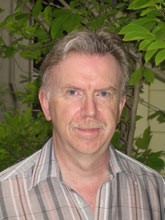
Handy Links
SLAC News Center
SLAC Today
- Subscribe
- Archives: Feb 2006-May 20, 2011
- Archives: May 23, 2011 and later
- Submit Feedback or Story Ideas
- About SLAC Today
SLAC News
Lab News
- Interactions
- Lightsources.org
- ILC NewsLine
- Int'l Science Grid This Week
- Fermilab Today
- Berkeley Lab News
- @brookhaven TODAY
- DOE Pulse
- CERN Courier
- DESY inForm
- US / LHC
SLAC Links
- Emergency
- Safety
- Policy Repository
- Site Entry Form

- Site Maps
- M & O Review
- Computing Status & Calendar
- SLAC Colloquium
- SLACspeak
- SLACspace
- SLAC Logo
- Café Menu
- Flea Market
- Web E-mail
- Marguerite Shuttle
- Discount Commuter Passes
-
Award Reporting Form
- SPIRES
- SciDoc
- Activity Groups
- Library
Stanford
Around the Bay
From the Director of Particle Physics and Astrophysics: Whither Scientific Computing at SLAC

Last week a new Scientific Computing Applications Department, SCA, was established within the Particle Physics and Astrophysics Directorate. The new group consolidates high-energy physics scientific applications expertise from existing experimental programs within PPA with some elements of the Computing Division scientific applications group. Most of these applications, such as GEANT4, data storage and server software, and data management tools, are unique to HEP. Thus, it makes sense to manage these activities directly within PPA where close connections to present and future PPA projects can be maintained. Certainly many future challenges in the computing applications arena are already visible with the PPA program, particularly the data volume and analysis requirements for the Large Synoptic Survey Telescope. These challenges will continue to attract talented scientific and engineering manpower that will bolster the long-term health of the SCA Department and ultimately the laboratory as a whole.
HEP experiments have historically tended to reinvent software and data management tools for each new application. Such an approach is clearly no longer efficient, particularly in an era when software applications are designed with broadly applicable requirements. Having solved the data pipeline, data management and data monitoring needs of the Large Area Telescope for the Fermi Gamma-ray Space Telescope mission, much of the software toolkit is now applicable to future mid-scale experiments, such as the Cold Dark Matter Search Super CDMS, the Enriched Xenon Observatory, and the Advanced Gamma-ray Imaging System. The PPA applications group is well positioned to extend existing techniques to these new projects to help define their needs and extend existing techniques or develop new ones as required for their science missions. The SCA Department also provides an effective conduit to the Computing Division and efforts in other science directorates, which should improve the overall science applications environment at the lab.
The trend toward treating scientific applications software as a community capability also is in line with the goals of the new HEP Computation Program within the DOE Office of High Energy Physics. GEANT4, SPIRES, and xrootd are three obvious examples of applications that serve the HEP community, which have already been proposed as prime candidates for the new program. It would not surprise me to see the list expand significantly, as DOE and the HEP community continue to identify key long-term needs and capabilities in the scientific computing arena.
Similarly, there are critical activities of wide interest to the entire SLAC scientific community which are best served by managing them as part of the Computing Division portfolio. Having created the SCA Department within PPA, I, along with the other members of the SLAC Executive Council, fully support this one-lab approach to scientific computing. Examples of scientific computing in this category at SLAC both now and in the future include large-scale commodity-based computing for data processing and analysis, mid-scale massively-parallel computing for state-of-the-art simulations, high performance disk servers and tape storage capabilities, and scientific applications software tools such as next generation database tools like XLDB and SciDB, which will enable data access and analysis across a wide array of science problems both here at SLAC and elsewhere.
We are still moving down a path of recognizing those elements of scientific computing that are of broad interest to our scientific community at SLAC, those elements which are an essential underpinning for scientific analysis, and those elements which will through nurturing and development be the stimulus for future capabilities and discoveries. These activities clearly should be part of the suite of capabilities and services offered through the Computing Division. However, the list will not be static. As requirements and needs for various scientific communities mature and evolve, as new funding sources and scientific computing problems are identified, as new ideas emerge from the scientific community undoubtedly there will be changes to the capabilities incorporated centrally into the Computing Division.
Right now PPA is the steward of some scientific computing capabilities, particularly in the data management area, which may be of interest in other scientific communities at SLAC. The SCA Department is structured as a professional center, with a keen interest in serving the wider SLAC audience should it emerge. Such an eventuality may lead to the addition of new capabilities into the Computing Division and a new alignment between science directorate activities and the Computing Division mission.
Change is part of the SLAC environment; it reflects a dynamic scientific culture of the laboratory and as a result we should continue to be vigilant in optimizing scientific computing and recognizing new opportunities at SLAC for an ever evolving scientific mission.
